TOYOTA SUPRA 2019 Owners Manual
Manufacturer: TOYOTA, Model Year: 2019, Model line: SUPRA, Model: TOYOTA SUPRA 2019Pages: 456, PDF Size: 88.65 MB
Page 271 of 456
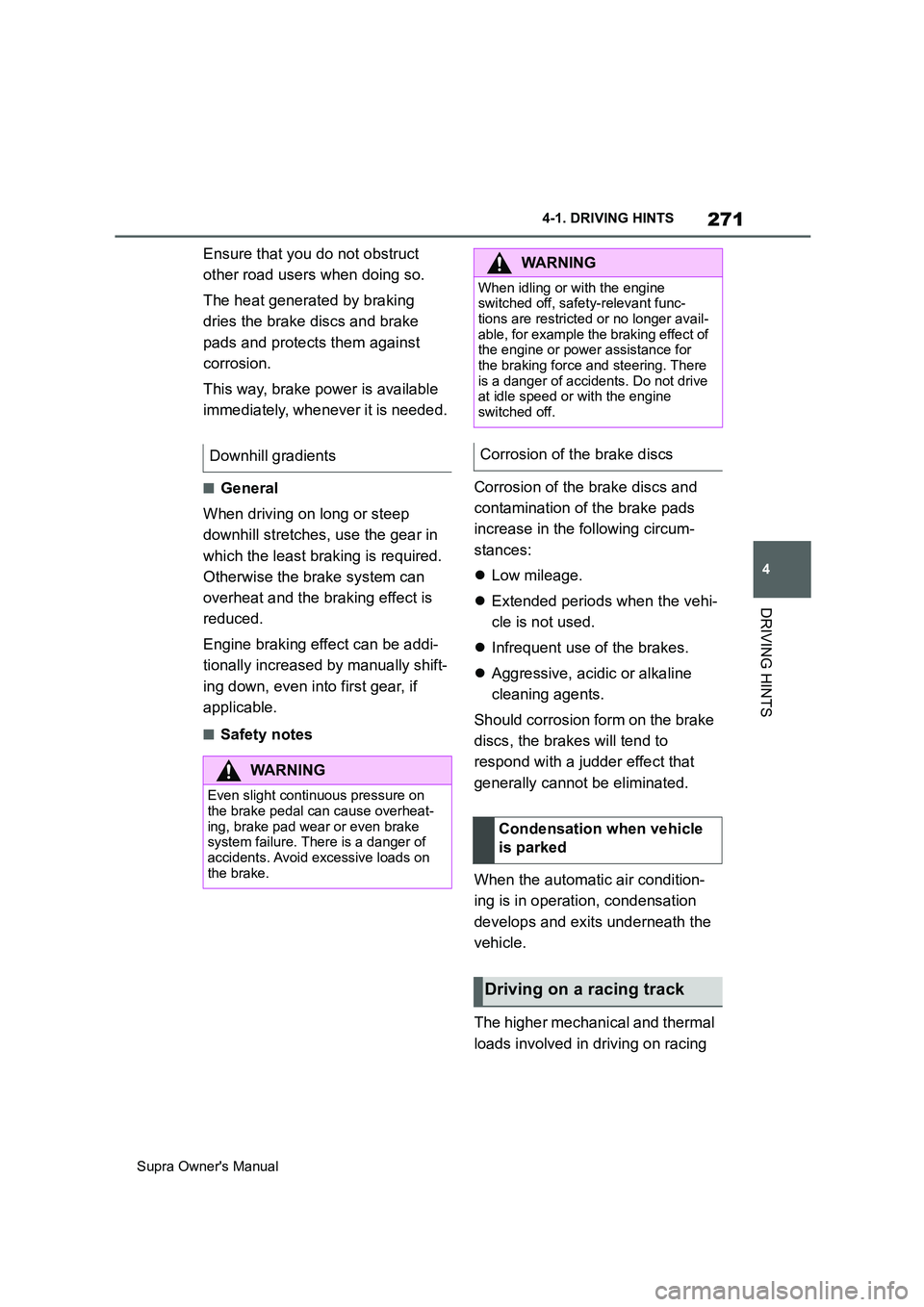
271
4
Supra Owner's Manual4-1. DRIVING HINTS
DRIVING HINTS
Ensure that you do not obstruct
other road users when doing so.
The heat generated by braking
dries the brake discs and brake
pads and protects them against
corrosion.
This way, brake power is available
immediately, whenever it is needed.
■General
When driving on long or steep
downhill stretches, use the gear in
which the least braking is required.
Otherwise the brake system can
overheat and the braking effect is
reduced.
Engine braking effect can be addi-
tionally increased by manually shift-
ing down, even into first gear, if
applicable.
■Safety notesCorrosion of the brake discs and
contamination of the brake pads
increase in the following circum-
stances:
Low mileage.
Extended periods when the vehi-
cle is not used.
Infrequent use of the brakes.
Aggressive, acidic or alkaline
cleaning agents.
Should corrosion form on the brake
discs, the brakes will tend to
respond with a judder effect that
generally cannot be eliminated.
When the automatic air condition-
ing is in operation, condensation
develops and exits underneath the
vehicle.
The higher mechanical and thermal
loads involved in driving on racing Downhill gradients
WARNING
Even slight continuous pressure on
the brake pedal can cause overheat-
ing, brake pad wear or even brake
system failure. There is a danger of
accidents. Avoid excessive loads on
the brake.
WARNING
When idling or with the engine
switched off, safety-relevant func-
tions are restricted or no longer avail-
able, for example the braking effect of
the engine or power assistance for
the braking force and steering. There
is a danger of accidents. Do not drive
at idle speed or with the engine
switched off.
Corrosion of the brake discs
Condensation when vehicle
is parked
Driving on a racing track
Page 272 of 456
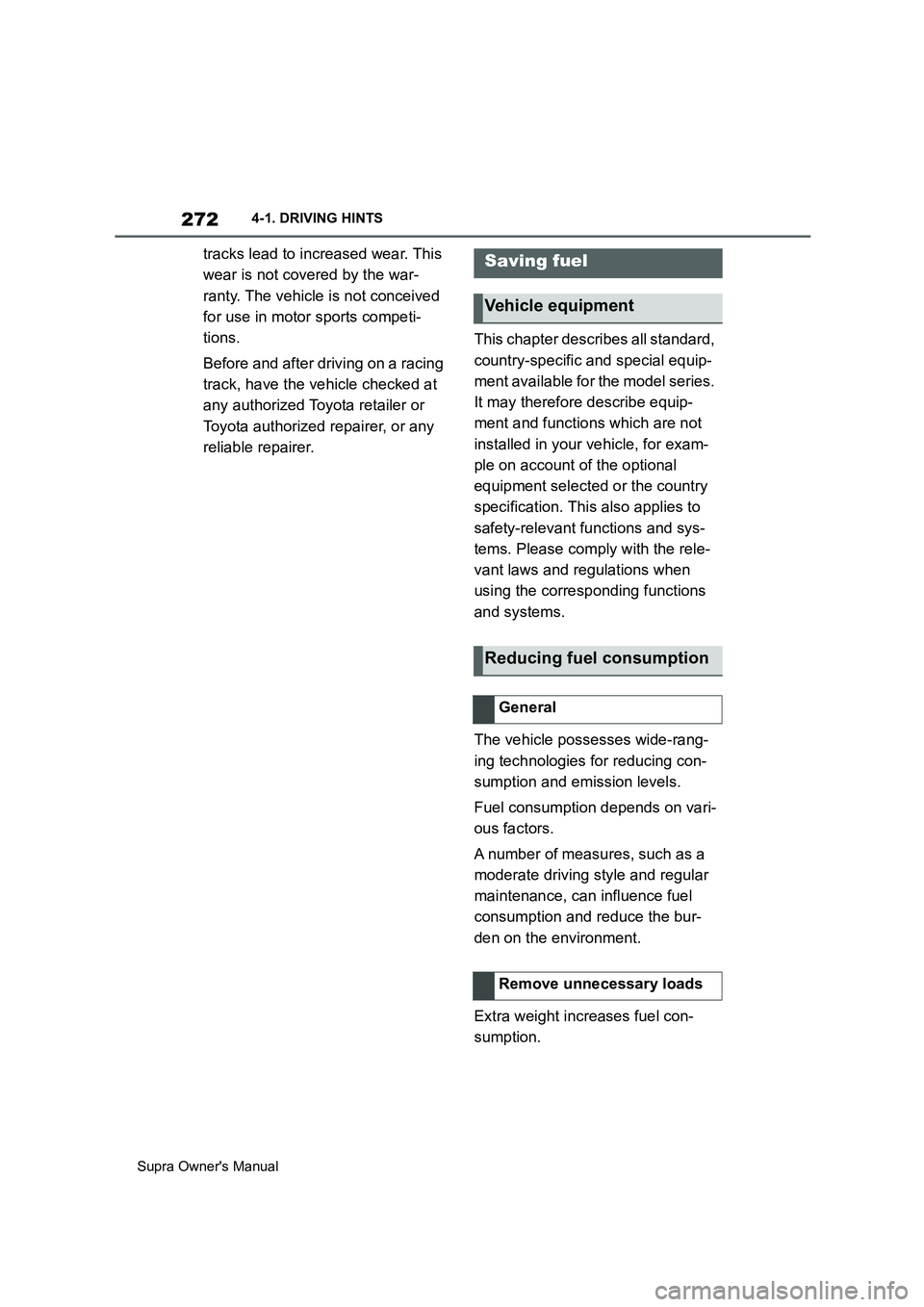
272
Supra Owner's Manual4-1. DRIVING HINTS
tracks lead to increased wear. This
wear is not covered by the war-
ranty. The vehicle is not conceived
for use in motor sports competi-
tions.
Before and after driving on a racing
track, have the vehicle checked at
any authorized Toyota retailer or
Toyota authorized repairer, or any
reliable repairer.This chapter describes all standard,
country-specific and special equip-
ment available for the model series.
It may therefore describe equip-
ment and functions which are not
installed in your vehicle, for exam-
ple on account of the optional
equipment selected or the country
specification. This also applies to
safety-relevant functions and sys-
tems. Please comply with the rele-
vant laws and regulations when
using the corresponding functions
and systems.
The vehicle possesses wide-rang-
ing technologies for reducing con-
sumption and emission levels.
Fuel consumption depends on vari-
ous factors.
A number of measures, such as a
moderate driving style and regular
maintenance, can influence fuel
consumption and reduce the bur-
den on the environment.
Extra weight increases fuel con-
sumption.Saving fuel
Vehicle equipment
Reducing fuel consumption
General
Remove unnecessary loads
Page 273 of 456
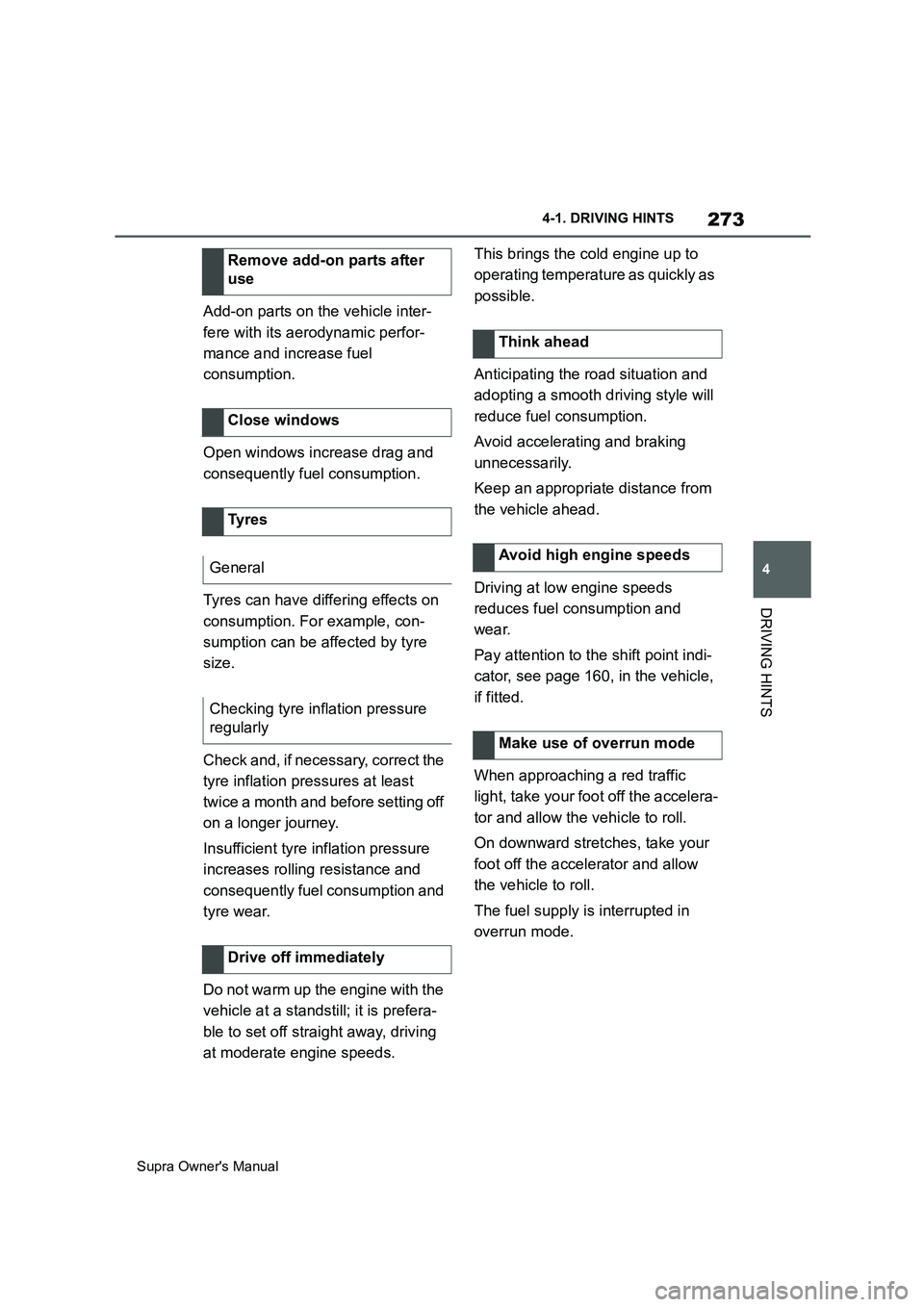
273
4
Supra Owner's Manual4-1. DRIVING HINTS
DRIVING HINTS
Add-on parts on the vehicle inter-
fere with its aerodynamic perfor-
mance and increase fuel
consumption.
Open windows increase drag and
consequently fuel consumption.
Tyres can have differing effects on
consumption. For example, con-
sumption can be affected by tyre
size.
Check and, if necessary, correct the
tyre inflation pressures at least
twice a month and before setting off
on a longer journey.
Insufficient tyre inflation pressure
increases rolling resistance and
consequently fuel consumption and
tyre wear.
Do not warm up the engine with the
vehicle at a standstill; it is prefera-
ble to set off straight away, driving
at moderate engine speeds.This brings the cold engine up to
operating temperature as quickly as
possible.
Anticipating the road situation and
adopting a smooth driving style will
reduce fuel consumption.
Avoid accelerating and braking
unnecessarily.
Keep an appropriate distance from
the vehicle ahead.
Driving at low engine speeds
reduces fuel consumption and
wear.
Pay attention to the shift point indi-
cator, see page 160, in the vehicle,
if fitted.
When approaching a red traffic
light, take your foot off the accelera-
tor and allow the vehicle to roll.
On downward stretches, take your
foot off the accelerator and allow
the vehicle to roll.
The fuel supply is interrupted in
overrun mode. Remove add-on parts after
use
Close windows
Ty r e s
General
Checking tyre inflation pressure
regularly
Drive off immediately
Think ahead
Avoid high engine speeds
Make use of overrun mode
Page 274 of 456
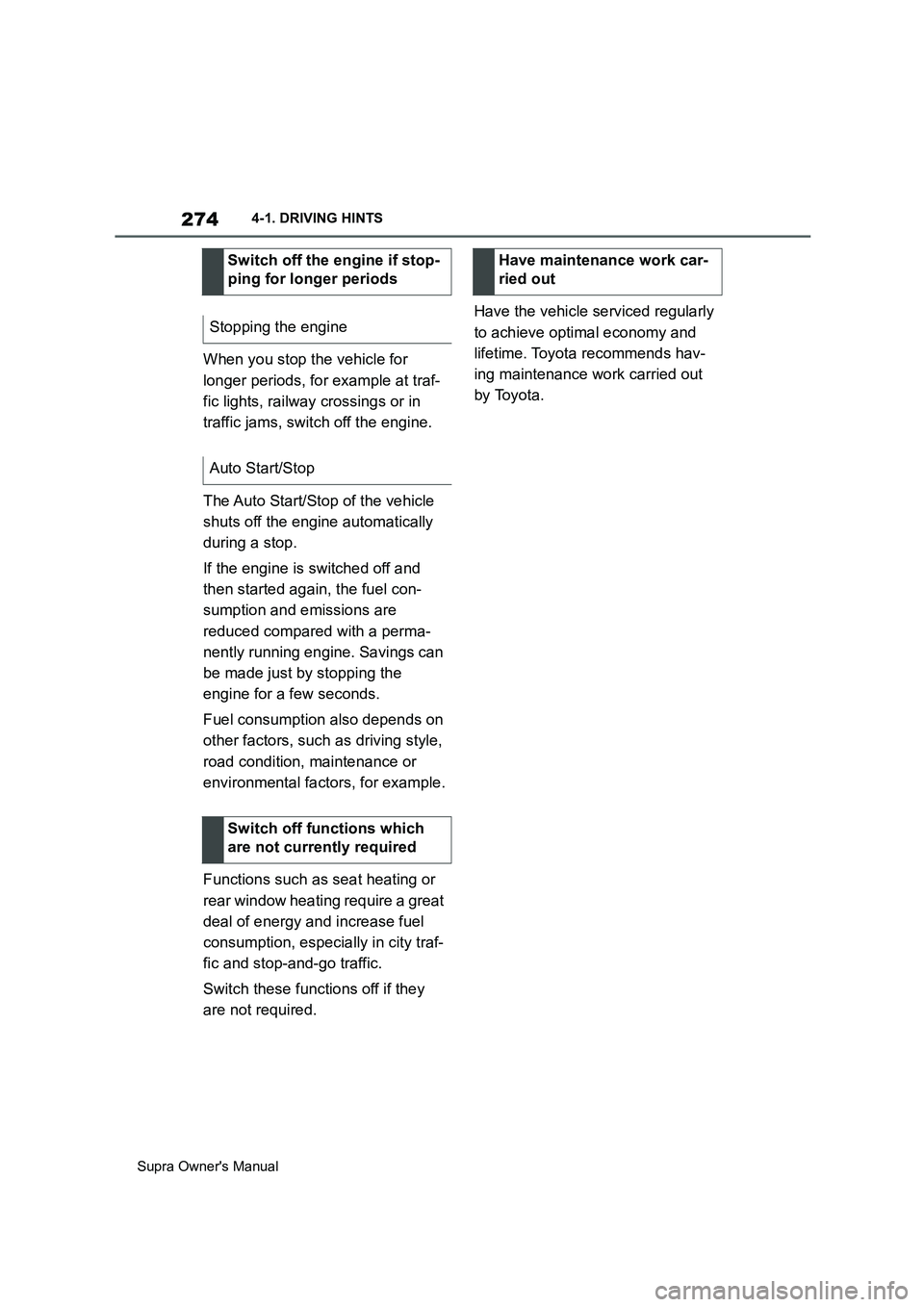
274
Supra Owner's Manual4-1. DRIVING HINTS
When you stop the vehicle for
longer periods, for example at traf-
fic lights, railway crossings or in
traffic jams, switch off the engine.
The Auto Start/Stop of the vehicle
shuts off the engine automatically
during a stop.
If the engine is switched off and
then started again, the fuel con-
sumption and emissions are
reduced compared with a perma-
nently running engine. Savings can
be made just by stopping the
engine for a few seconds.
Fuel consumption also depends on
other factors, such as driving style,
road condition, maintenance or
environmental factors, for example.
Functions such as seat heating or
rear window heating require a great
deal of energy and increase fuel
consumption, especially in city traf-
fic and stop-and-go traffic.
Switch these functions off if they
are not required.Have the vehicle serviced regularly
to achieve optimal economy and
lifetime. Toyota recommends hav-
ing maintenance work carried out
by Toyota. Switch off the engine if stop-
ping for longer periods
Stopping the engine
Auto Start/Stop
Switch off functions which
are not currently required
Have maintenance work car-
ried out
Page 275 of 456
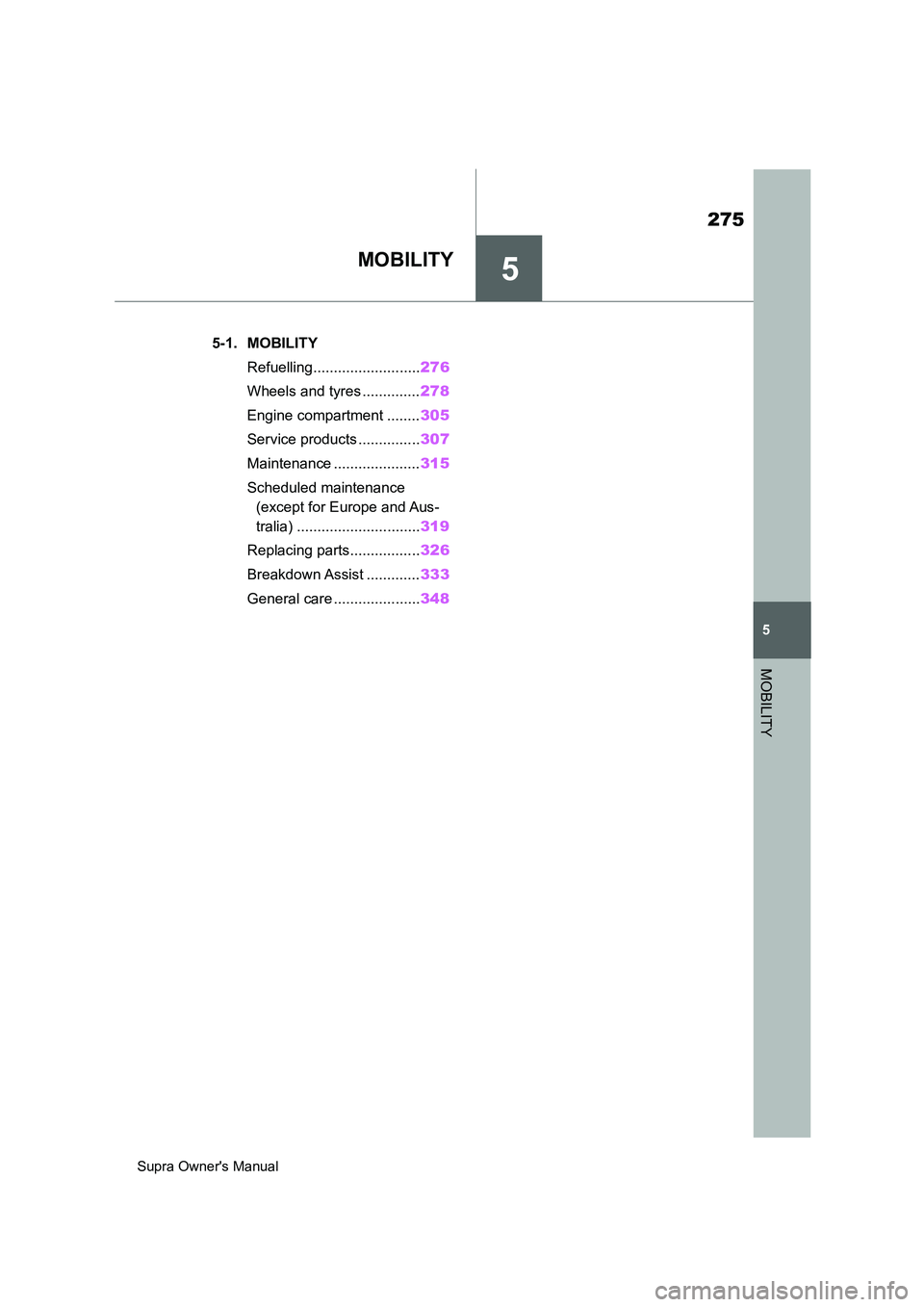
5
275
Supra Owner's Manual
5
MOBILITY
MOBILITY
.5-1. MOBILITY
Refuelling..........................276
Wheels and tyres ..............278
Engine compartment ........305
Service products ...............307
Maintenance .....................315
Scheduled maintenance
(except for Europe and Aus-
tralia) ..............................319
Replacing parts.................326
Breakdown Assist .............333
General care .....................348
Page 276 of 456
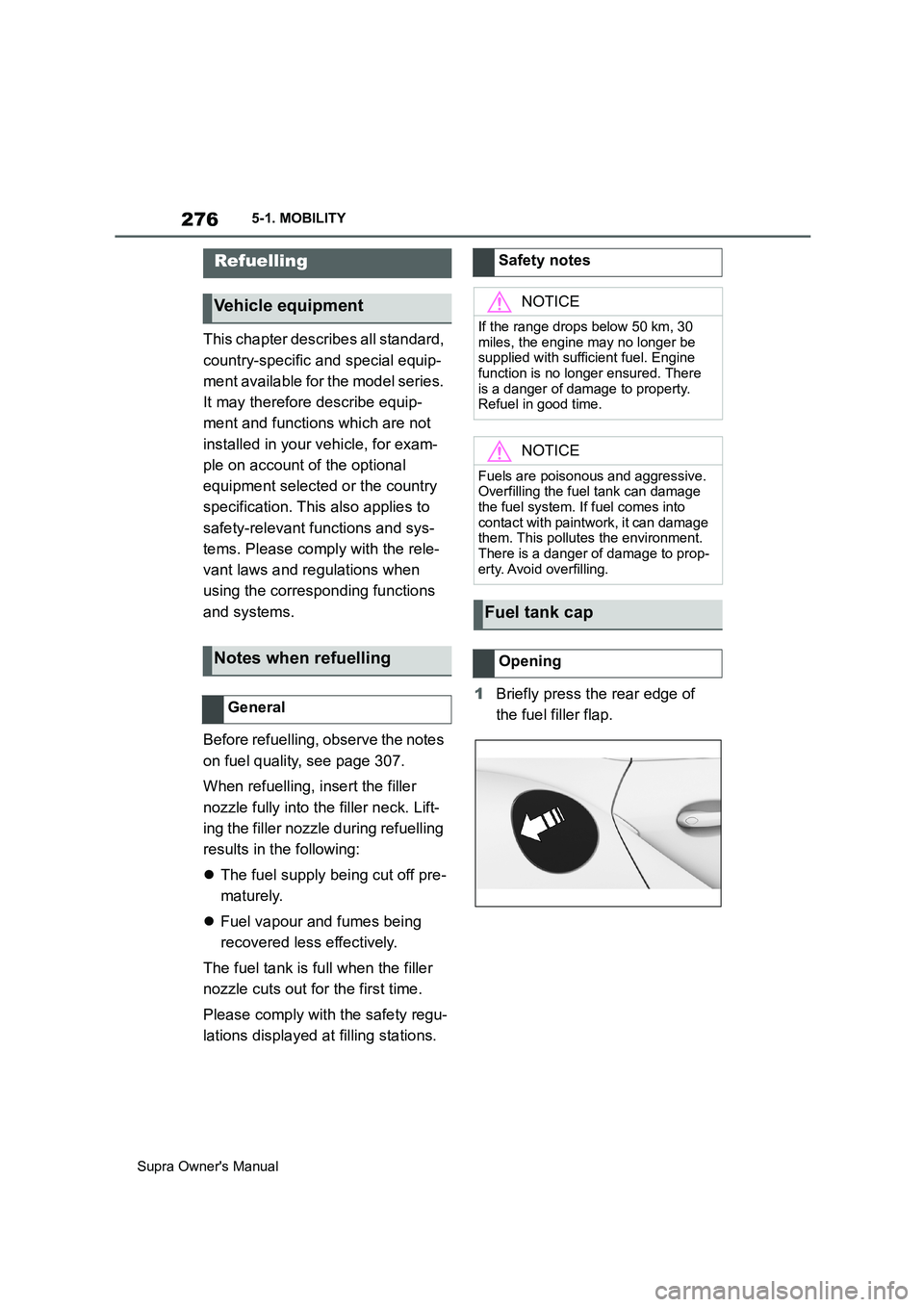
276
Supra Owner's Manual5-1. MOBILITY
5-1.MOBILITY
This chapter describes all standard,
country-specific and special equip-
ment available for the model series.
It may therefore describe equip-
ment and functions which are not
installed in your vehicle, for exam-
ple on account of the optional
equipment selected or the country
specification. This also applies to
safety-relevant functions and sys-
tems. Please comply with the rele-
vant laws and regulations when
using the corresponding functions
and systems.
Before refuelling, observe the notes
on fuel quality, see page 307.
When refuelling, insert the filler
nozzle fully into the filler neck. Lift-
ing the filler nozzle during refuelling
results in the following:
The fuel supply being cut off pre-
maturely.
Fuel vapour and fumes being
recovered less effectively.
The fuel tank is full when the filler
nozzle cuts out for the first time.
Please comply with the safety regu-
lations displayed at filling stations.1Briefly press the rear edge of
the fuel filler flap.
Refuelling
Vehicle equipment
Notes when refuelling
General
Safety notes
NOTICE
If the range drops below 50 km, 30
miles, the engine may no longer be
supplied with sufficient fuel. Engine
function is no longer ensured. There
is a danger of damage to property.
Refuel in good time.
NOTICE
Fuels are poisonous and aggressive.
Overfilling the fuel tank can damage
the fuel system. If fuel comes into
contact with paintwork, it can damage
them. This pollutes the environment.
There is a danger of damage to prop-
erty. Avoid overfilling.
Fuel tank cap
Opening
Page 277 of 456
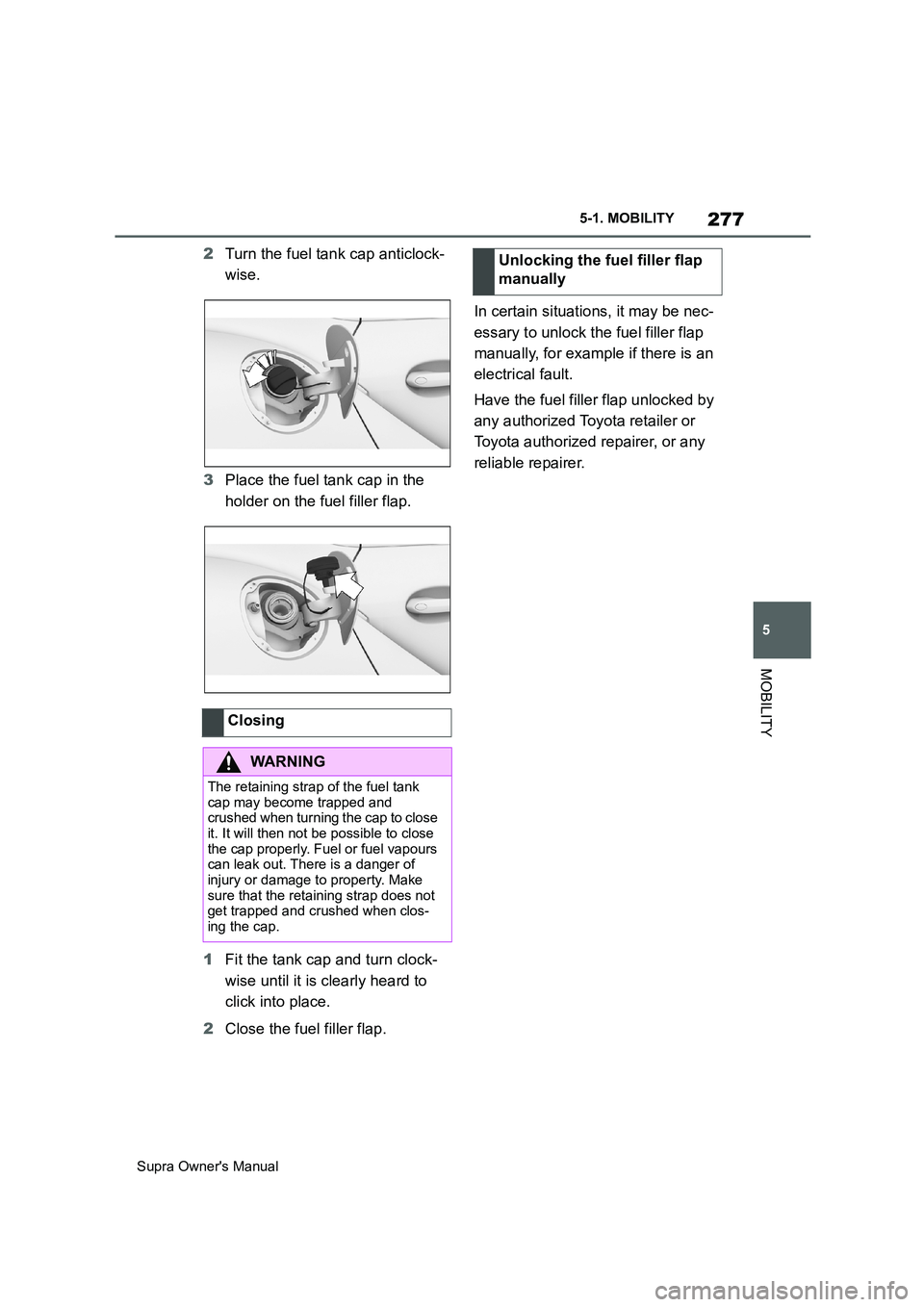
277
5
Supra Owner's Manual5-1. MOBILITY
MOBILITY
2Turn the fuel tank cap anticlock-
wise.
3Place the fuel tank cap in the
holder on the fuel filler flap.
1Fit the tank cap and turn clock-
wise until it is clearly heard to
click into place.
2Close the fuel filler flap.In certain situations, it may be nec-
essary to unlock the fuel filler flap
manually, for example if there is an
electrical fault.
Have the fuel filler flap unlocked by
any authorized Toyota retailer or
Toyota authorized repairer, or any
reliable repairer.
Closing
WARNING
The retaining strap of the fuel tank
cap may become trapped and
crushed when turning the cap to close
it. It will then not be possible to close
the cap properly. Fuel or fuel vapours
can leak out. There is a danger of
injury or damage to property. Make
sure that the retaining strap does not
get trapped and crushed when clos-
ing the cap.
Unlocking the fuel filler flap
manually
Page 278 of 456
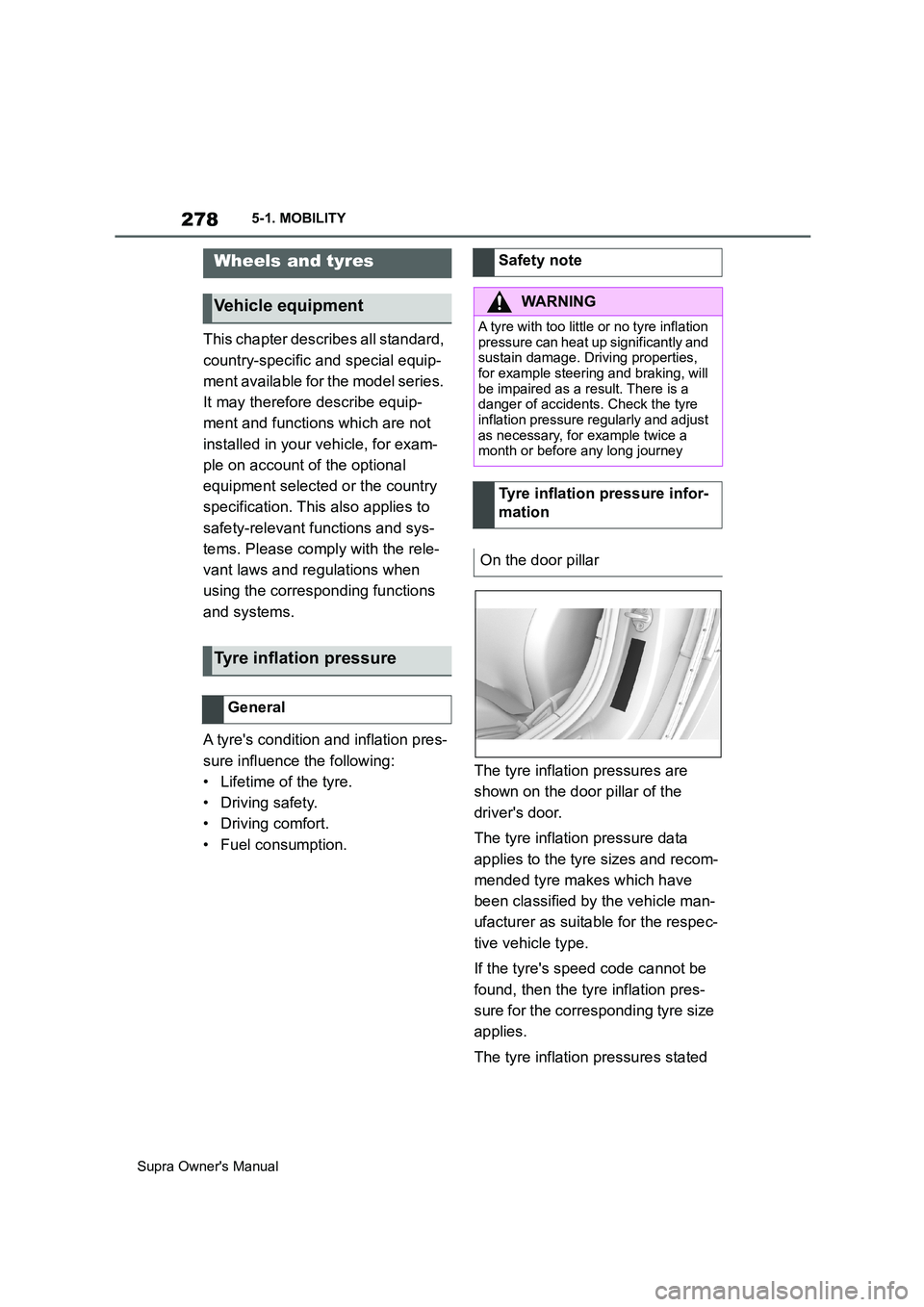
278
Supra Owner's Manual5-1. MOBILITY
This chapter describes all standard,
country-specific and special equip-
ment available for the model series.
It may therefore describe equip-
ment and functions which are not
installed in your vehicle, for exam-
ple on account of the optional
equipment selected or the country
specification. This also applies to
safety-relevant functions and sys-
tems. Please comply with the rele-
vant laws and regulations when
using the corresponding functions
and systems.
A tyre's condition and inflation pres-
sure influence the following:
• Lifetime of the tyre.
• Driving safety.
• Driving comfort.
• Fuel consumption.The tyre inflation pressures are
shown on the door pillar of the
driver's door.
The tyre inflation pressure data
applies to the tyre sizes and recom-
mended tyre makes which have
been classified by the vehicle man-
ufacturer as suitable for the respec-
tive vehicle type.
If the tyre's speed code cannot be
found, then the tyre inflation pres-
sure for the corresponding tyre size
applies.
The tyre inflation pressures stated
Wheels and tyres
Vehicle equipment
Tyre inflation pressure
General
Safety note
WARNING
A tyre with too little or no tyre inflation
pressure can heat up significantly and
sustain damage. Driving properties,
for example steering and braking, will
be impaired as a result. There is a
danger of accidents. Check the tyre
inflation pressure regularly and adjust
as necessary, for example twice a
month or before any long journey
Tyre inflation pressure infor-
mation
On the door pillar
Page 279 of 456
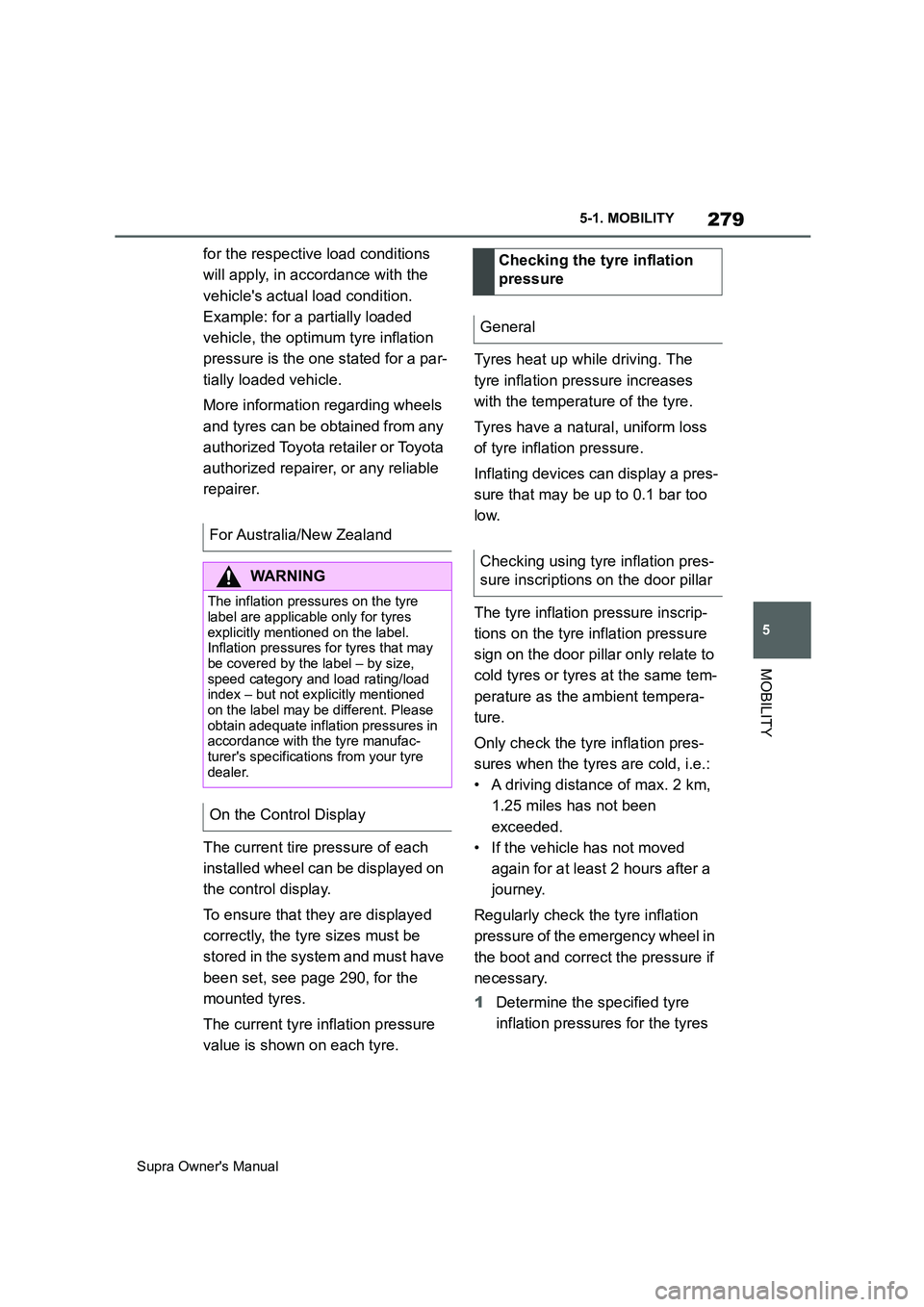
279
5
Supra Owner's Manual5-1. MOBILITY
MOBILITY
for the respective load conditions
will apply, in accordance with the
vehicle's actual load condition.
Example: for a partially loaded
vehicle, the optimum tyre inflation
pressure is the one stated for a par-
tially loaded vehicle.
More information regarding wheels
and tyres can be obtained from any
authorized Toyota retailer or Toyota
authorized repairer, or any reliable
repairer.
The current tire pressure of each
installed wheel can be displayed on
the control display.
To ensure that they are displayed
correctly, the tyre sizes must be
stored in the system and must have
been set, see page 290, for the
mounted tyres.
The current tyre inflation pressure
value is shown on each tyre.Tyres heat up while driving. The
tyre inflation pressure increases
with the temperature of the tyre.
Tyres have a natural, uniform loss
of tyre inflation pressure.
Inflating devices can display a pres-
sure that may be up to 0.1 bar too
low.
The tyre inflation pressure inscrip-
tions on the tyre inflation pressure
sign on the door pillar only relate to
cold tyres or tyres at the same tem-
perature as the ambient tempera-
ture.
Only check the tyre inflation pres-
sures when the tyres are cold, i.e.:
• A driving distance of max. 2 km,
1.25 miles has not been
exceeded.
• If the vehicle has not moved
again for at least 2 hours after a
journey.
Regularly check the tyre inflation
pressure of the emergency wheel in
the boot and correct the pressure if
necessary.
1Determine the specified tyre
inflation pressures for the tyres For Australia/New Zealand
WARNING
The inflation pressures on the tyre
label are applicable only for tyres
explicitly mentioned on the label.
Inflation pressures for tyres that may
be covered by the label – by size,
speed category and load rating/load
index – but not explicitly mentioned
on the label may be different. Please
obtain adequate inflation pressures in
accordance with the tyre manufac-
turer's specifications from your tyre
dealer.
On the Control Display
Checking the tyre inflation
pressure
General
Checking using tyre inflation pres-
sure inscriptions on the door pillar
Page 280 of 456
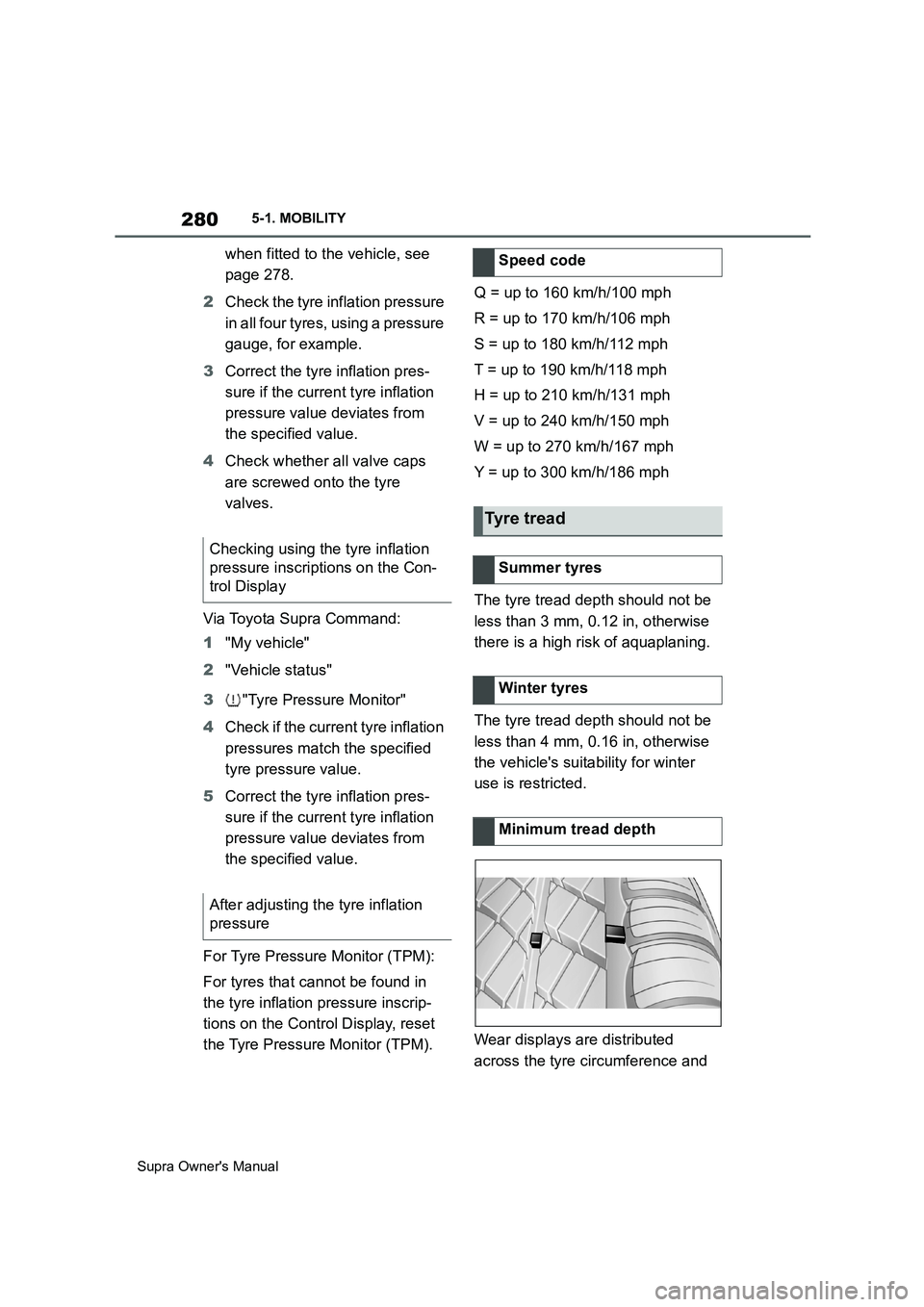
280
Supra Owner's Manual5-1. MOBILITY
when fitted to the vehicle, see
page 278.
2Check the tyre inflation pressure
in all four tyres, using a pressure
gauge, for example.
3Correct the tyre inflation pres-
sure if the current tyre inflation
pressure value deviates from
the specified value.
4Check whether all valve caps
are screwed onto the tyre
valves.
Via Toyota Supra Command:
1"My vehicle"
2"Vehicle status"
3"Tyre Pressure Monitor"
4Check if the current tyre inflation
pressures match the specified
tyre pressure value.
5Correct the tyre inflation pres-
sure if the current tyre inflation
pressure value deviates from
the specified value.
For Tyre Pressure Monitor (TPM):
For tyres that cannot be found in
the tyre inflation pressure inscrip-
tions on the Control Display, reset
the Tyre Pressure Monitor (TPM).Q = up to 160 km/h/100 mph
R = up to 170 km/h/106 mph
S = up to 180 km/h/112 mph
T = up to 190 km/h/118 mph
H = up to 210 km/h/131 mph
V = up to 240 km/h/150 mph
W = up to 270 km/h/167 mph
Y = up to 300 km/h/186 mph
The tyre tread depth should not be
less than 3 mm, 0.12 in, otherwise
there is a high risk of aquaplaning.
The tyre tread depth should not be
less than 4 mm, 0.16 in, otherwise
the vehicle's suitability for winter
use is restricted.
Wear displays are distributed
across the tyre circumference and Checking using the tyre inflation
pressure inscriptions on the Con-
trol Display
After adjusting the tyre inflation
pressureSpeed code
Tyre tread
Summer tyres
Winter tyres
Minimum tread depth